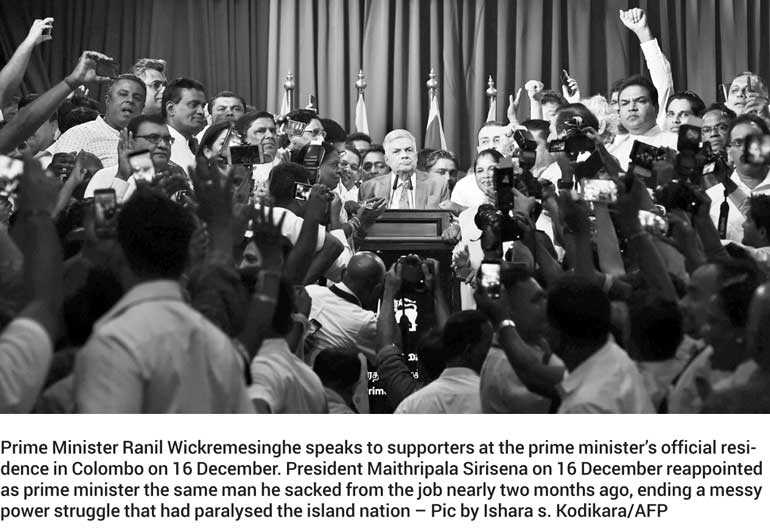Sunday Dec 07, 2025
Sunday Dec 07, 2025
Saturday, 22 December 2018 00:10 - - {{hitsCtrl.values.hits}}

By Dr. Jehan Perera
www.ucanews.com: The restoration of Ranil Wickremesinghe as Sri Lanka’s Prime Minister by President Maithripala Sirisena has brought to an end seven weeks of political crisis in which the country did not have a functioning government.
There have been many losers, and a few winners, in Sri Lanka’s drawn-out constitutional crisis precipitated by Sirisena removing Wickremesinghe on 26 October even though he enjoyed a parliamentary majority.
On that fateful day, Sirisena’s erstwhile ally was replaced with Mahinda Rajapaksa, previously a bitter political foe.
In January 2015, Wickremesinghe and Sirisena teamed up to defeat Rajapaksa at presidential elections.
It required two crucial decisions by the country’s highest courts to get a recalcitrant Rajapaksa to step down as prime minister and for the President to reappoint the ousted Premier.
As Christmas approaches, there are losers all round.
The biggest loser has been Rajapaksa.
Although Wickremesinghe had the confirmed backing of a majority of parliamentarians, Rajapaksa refused to step down.
He finally submitted his resignation when the courts held that his two successive defeats in no-confidence motions in Parliament merited further inquiry as to whether he was entitled to remain prime minister.
With the political crisis dragging on, Sri Lanka’s economy has been taking a beating. The United States suspended a $ 400 million Millennium Challenge infrastructure project. And financial ratings of international credit agencies dropped.
Ironically, shortly before political tensions erupted into outright hostility, the Lonely Planet travel magazine voted Sri Lanka as the world’s top tourist destination.
But peak season tourist bookings crashed, following negative travel advisories from several countries, and many hotels are only half full.
Indeed, Sirisena could not have chosen a worse time to stage what was branded a constitutional coup by sacking a prime minister who commanded a majority in Parliament.
However, two sectors of society have made gains that could, in the longer term, serve the interests of the country well.
The stature of the Judiciary has grown. At a time when the executive branches of governments in many parts of the world are dominating legislatures and judiciaries, Sri Lanka showed itself to be different. The Sri Lankan Judiciary succeeded in taming the politicians who would run amok in both the Executive and Legislature.
First, judges held that the Sri Lankan Constitution did not permit the President to dissolve Parliament so early in a parliamentary term. While the 19th Amendment to the Constitution specifies that Parliament can only be dissolved by the President after four-and-a-half years, here this was done when barely more than three years of its five-year term had elapsed.
Next the judges held that Rajapaksa, who was defeated in no-confidence votes in Parliament but refused to step down, could not continue to act in the role until the case was decided.
As a result, the stock of the Judiciary is at an all-time high along with civil society that has taken a principled stance in upholding the constitution and the rule of law. Civil society groups were active in explaining the constitutional issues involved to a bemused population and in publicly challenging politicians who hold contrary views. The clear violation of constitutional norms and parliamentary traditions led to unified civil society activism. They campaigned hard and with unity of purpose.
Civil society activists found common cause with political groupings that objected to what had happened.
And many leaders of Christian churches in the majority-Buddhist nation forthrightly expressed views on the political crisis.
Underlying the arguments put forward by supporters of the President’s actions was the notion that the sovereignty of the people is uppermost in a democracy. Both Sirisena and Rajapaksa said that the way out of the political crisis was early elections.
According to them, the sovereignty of the people, and their readiness to go to the people for a new mandate, justified the drastic actions that the President had taken in disregard of the constitution, sacking first the Prime Minister and then the Parliament. What was at stake in this political power struggle was adherence to the Constitution as the foundation of the rule of law that civilises the use of power by setting boundaries. Constitutional provisions enshrined in laws are not, as Sirisena seems to have been misadvised, mere guidelines for action. If the rules of the game were not followed this time, next time the violations could be worse.
A group of top-ranking clergy from the Anglican, Methodist and Baptist churches engaged in mediation between the political leaders at the centre of the power struggle. They made it clear that progress towards a solution could only be achieved if wrongs already done are first corrected.
The common position of civil society, as well as political parties currently forced into opposition, was that there should be a return to the 26 October status quo. Their main concern was that an unhealthy precedent would be set for presidents to act as tyrants without respect for the Constitution or the rule of law.
Now that the Constitution has been adhered to and rule of law followed, there is renewed hope that Sri Lanka will mature and emerge as a more united polity.
(Jehan Perera is Executive Director of the National Peace Council of Sri Lanka. He is a regular weekly political columnist for newspapers both in Sri Lanka and internationally. He holds a Doctor of Law degree from Harvard Law School and a B.A. in Economics from Harvard College.)
(Source: https://www.ucanews.com/news/losers-and-winners-in-sri-lankas-political-crisis/84115)